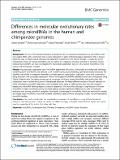Por favor, use este identificador para citar o enlazar a este item:
http://hdl.handle.net/10261/150607COMPARTIR / EXPORTAR:
 SHARE SHARE
 CORE
BASE CORE
BASE
|
|
| Visualizar otros formatos: MARC | Dublin Core | RDF | ORE | MODS | METS | DIDL | DATACITE | |

| Campo DC | Valor | Lengua/Idioma |
|---|---|---|
| dc.contributor.author | Santpere, Gabriel | es_ES |
| dc.contributor.author | López Valenzuela, María | es_ES |
| dc.contributor.author | Petit-Marty, Natalia | es_ES |
| dc.contributor.author | Navarro, Arcadi | es_ES |
| dc.contributor.author | Espinosa-Parrilla, Yolanda | es_ES |
| dc.date.accessioned | 2017-05-30T07:04:03Z | - |
| dc.date.available | 2017-05-30T07:04:03Z | - |
| dc.date.issued | 2016-07-29 | - |
| dc.identifier.citation | BMC Genomics 17: 528 (2016) | es_ES |
| dc.identifier.issn | 1471-2164 | - |
| dc.identifier.uri | http://hdl.handle.net/10261/150607 | - |
| dc.description.abstract | [Background] The rise of the primate lineage is accompanied by an outstanding emergence of microRNAs, small non-coding RNAs with a prominent role in gene regulation. In spite of their biological importance little is known about the way in which natural selection has influenced microRNAs in the human lineage. To study the recent evolutionary history of human microRNAs and to analyze the signatures of natural selection in genomic regions harbouring microRNAs we have investigated the nucleotide substitution rates of 1,872 human microRNAs in the human and chimpanzee lineages. | es_ES |
| dc.description.abstract | [Results] We produced a depurated set of microRNA alignments of human, chimpanzee and orang-utan orthologs combining BLAT and liftOver and selected 1,214 microRNA precursors presenting optimal secondary structures. We classified microRNAs in categories depending on their genomic organization, duplication status and conservation along evolution. We compared substitution rates of the aligned microRNAs between human and chimpanzee using Tajima’s Relative Rate Test taking orang-utan as out-group and found several microRNAs with particularly high substitution rates in either the human or chimpanzee branches. We fitted different models of natural selection on these orthologous microRNA alignments and compared them using a likelihood ratio test that uses ancestral repeats and microRNA flanking regions as neutral sequences. We found that although a large fraction of human microRNAs is highly conserved among the three species studied, significant differences in rates of molecular evolution exist among microRNA categories. Particularly, primate-specific microRNAs, which are enriched in isolated and single copy microRNAs, more than doubled substitution rates of those belonging to older, non primate-specific microRNA families. | es_ES |
| dc.description.abstract | [Conclusions] Our results corroborate the remarkable conservation of microRNAs, a proxy of their functional relevance, and indicate that a subset of human microRNAs undergo nucleotide substitutions at higher rates, which may be suggestive of the action of positive selection. | es_ES |
| dc.description.sponsorship | This work was supported by the Ministerio de Ciencia e Innovación, España (BFU2012-38236, BFU2010-18477, BFU2009-06974, and CGL2009-09013), Direcció General de Recerca de la Generalitat de Catalunya” (2009SGR-1101, 2014SGR-866 and SGR2014-1311) and European Union Seventh Framework Programme (PIOF-GA-2009-236836 and PIRSES-GA-2013-612583). This publication has been cofinanced by FEDER —European Regional Development Fund “A way to build Europe.” MLV is funded by a Beca per a la Formació de Personal Investigador (FI) fellowship from the Agència de Gestió d’Ajuts Universitaris i de Recerca, Generalitat de Catalunya. | es_ES |
| dc.language.iso | eng | es_ES |
| dc.publisher | BioMed Central | es_ES |
| dc.relation | info:eu-repo/grantAgreement/EC/FP7/236836 | es_ES |
| dc.relation | info:eu-repo/grantAgreement/EC/FP7/612583 | es_ES |
| dc.relation.isversionof | Publisher's version | es_ES |
| dc.rights | openAccess | es_ES |
| dc.subject | MicroRNAs | es_ES |
| dc.subject | Acceleration rates | es_ES |
| dc.subject | Primates | es_ES |
| dc.subject | Divergence | es_ES |
| dc.subject | microRNA cluster | es_ES |
| dc.subject | Evolution | es_ES |
| dc.title | Differences in molecular evolutionary rates among microRNAs in the human and chimpanzee genomes | es_ES |
| dc.type | artículo | es_ES |
| dc.identifier.doi | 10.1186/s12864-016-2863-3 | - |
| dc.description.peerreviewed | Peer reviewed | es_ES |
| dc.relation.publisherversion | http://dx.doi.org/10.1186/s12864-016-2863-3 | es_ES |
| dc.rights.license | http://creativecommons.org/licenses/by/4.0/ | es_ES |
| dc.contributor.funder | Ministerio de Ciencia e Innovación (España) | es_ES |
| dc.contributor.funder | Generalitat de Catalunya | es_ES |
| dc.contributor.funder | European Commission | es_ES |
| dc.relation.csic | Sí | es_ES |
| oprm.item.hasRevision | no ko 0 false | * |
| dc.identifier.funder | http://dx.doi.org/10.13039/501100004837 | es_ES |
| dc.identifier.funder | http://dx.doi.org/10.13039/501100002809 | es_ES |
| dc.identifier.funder | http://dx.doi.org/10.13039/501100000780 | es_ES |
| dc.identifier.pmid | 27474039 | - |
| dc.type.coar | http://purl.org/coar/resource_type/c_6501 | es_ES |
| item.openairetype | artículo | - |
| item.grantfulltext | open | - |
| item.cerifentitytype | Publications | - |
| item.openairecristype | http://purl.org/coar/resource_type/c_18cf | - |
| item.fulltext | With Fulltext | - |
| item.languageiso639-1 | en | - |
| Aparece en las colecciones: | (IBE) Artículos | |
Ficheros en este ítem:
| Fichero | Descripción | Tamaño | Formato | |
|---|---|---|---|---|
| chimpanzee_genomes_Santpere.pdf | 682,04 kB | Adobe PDF |  Visualizar/Abrir |
CORE Recommender
PubMed Central
Citations
8
checked on 10-abr-2024
SCOPUSTM
Citations
11
checked on 15-abr-2024
WEB OF SCIENCETM
Citations
9
checked on 24-feb-2024
Page view(s)
309
checked on 18-abr-2024
Download(s)
221
checked on 18-abr-2024

